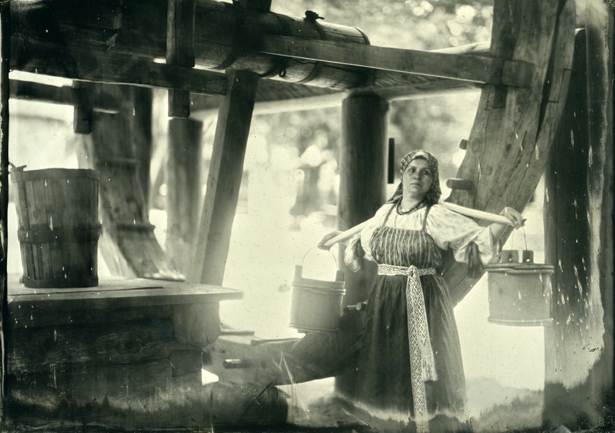How Russian peasants lived 2 centuries ago

The city of Nizhny Novgorod (420 km from Moscow) is home to the Shchelokovsky Farmstead Ethnographic Museum, a microcosm of 19th-century Russian village life with huts, barns, mills and 17th and 18th-century churches. These unique monuments of wooden architecture were brought here from districts in the Transvolga region. The building interiors have been restored to their original condition, and are filled with objects of everyday peasant life. Photographer Misha Burlatsky took old-style shots of 21st-century people, seemingly transported back in time and reincarnated as their ancestors. \ A well brought from the town of Gorodets, 50 km from Nizhny Novgorod.
Misha Burlatsky
Be it a river, lake or pond, the approach to any body of water in the village was always a wooden walkway used for diving, collecting water for the home and garden, and washing clothes.
Misha Burlatsky
Pilgrims. Old Believer monasteries in the Transvolga region of Nizhny Novgorod received just as many pilgrims as Orthodox monasteries in the southern districts.
Misha Burlatsky
The festive costume of a peasant was richly decorated with gold embroidery. Reconstruction by L. Tsyplakova (model by Julia Beketova).
Misha Burlatsky
Female prayer costume worn by Old Believers in the Transvolga region of Nizhny Novgorod. It consists of a silk sarafan (sundress), sleeves and headscarf decorated with embroidery (model by Svetlana Agapova).
Misha Burlatsky
The costume of a prosperous peasant from Gorbatovsky District: ribbons embroidered with gold and pearls, necklace, kosnik (a ribbon woven into a plait), round sarafan on crinoline and silk sleeves (reconstruction by L. Tsyplakova).
Misha Burlatsky
Festive costumes of peasants from Vetluzhsky District: checked round sarafans worn as over- and undergarments, cross-embroidered shirts, woven belts. Traditional musical instruments for folk festivities: tambourine and balalaika.
Misha Burlatsky
In the evening, girls would sit in "monastic cells" and chat to each other while spinning flax with the help of depicted objects.
Misha Burlatsky
The haymaking season started on the same day for all villagers. On this day women wore special "mowing" shirts, brightly colored or richly embroidered along the hem. This shirt could be worn without a sarafan.
Misha Burlatsky
Alms left on a windowsill.
Misha Burlatsky
Male shirt. Printed cotton with an embroidered cross on the chest. Reconstruction by I. Labud.
Misha Burlatsky
Typical costume for the south of the Nizhny Novgorod region: round sarafan, shirt, woven belt.
Misha Burlatsky
Church of the Intercession, 1731. Originally from the village of Starye Kluchischi, it is a wooden church with a refectory.
Misha Burlatsky
All rights reserved by Rossiyskaya Gazeta.
Subscribe
to our newsletter!
Get the week's best stories straight to your inbox